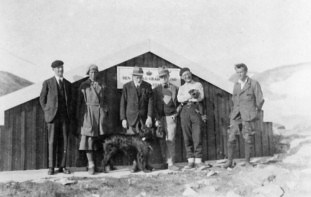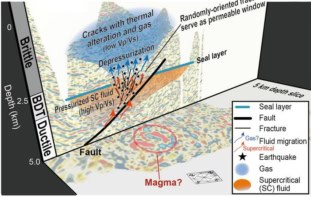The Deep Hot Biosphere Thomas Gold 1998 Copernicus 225pp £19.00/$27.00hb
On page 38 of this provocative book, Thomas Gold describes how he began “nosing around in the field of petroleum geology” only after establishing himself as an esteemed astronomer and physicist, and having been elected as a member of several prestigious learned societies. He would not recommend a scientist of lesser standing, “however brilliant”, to propose the sort of radical theories summarized here. For Gold’s thesis amounts to a total revision of much of the Earth sciences. If he is right, the consequences could be dramatic, not only for science, but also for economics and politics.
At the heart of the theory is the problem of the origin of hydrocarbons in the Earth’s crust. Conventional wisdom has it that oil and coal are remnants of ancient surface life that became buried and subjected to extremes of temperature and pressure. Gold maintains that these deposits are not fossil fuels in the normal sense, but the products of primordial hydrocarbons dating from the time of the Earth’s formation. He claims that over the aeons the volatile gases migrate towards the surface through cracks in the crust, and either leak into the atmosphere as methane, become trapped in sub-surface gas fields, or are robbed of their hydrogen to become oil, tar or carbonaceous material like coal. In other words, these substances are formed from the bottom up, rather than the top down. It follows that there must be reserves of fuel vastly in excess of the quantities that the gas and petroleum industry estimates.
When Gold proposed this theory in the early 1980s, few scientists took him seriously. However, he did persuade the Swedish State Power Board to drill into a slab of granite fractured by an ancient meteor impact. Since oil is supposed to be found only in sedimentary rocks, it was a good test of Gold’s theory. If gas is coming up from deep in the Earth, it might be expected to accumulate beneath the dense granite cap, and migrate slowly up through any fissures, perhaps turning into oil or tar. In the event, the prospectors did strike oil – about 12 tons of it. This was not enough to make the well commercially successful, but it did confirm that Gold was on to something.
It was not the Swedish oil that proved the most significant discovery though. Mixed in with the sludge at the bottom of the well, at a depth of over 6 km, was a large quantity of magnetite – a reduced form of iron oxide often associated with bacterial activity. After further investigation, Gold announced to the world that life exists not only on the surface of our planet but, in microbial form, deep inside the crust too.
The claim that the biosphere extends far underground was, if anything, even more heretical than the theory of upwelling hydrocarbons. At the time it was greeted with widespread scepticism. But I, for one, immediately found the basic idea plausible. As it happened, within a few years other researchers also obtained evidence for deep-living microbes, not only beneath the land, but also under the sea bed. Soon, microbes were being extracted from deep bore holes and cultured in the laboratory. Today there is no doubt that the underworld teems with life, as Gold asserted all along, although the precise extent of this subterranean realm remains uncertain.
Many of the deepest dwelling organisms are “hyperthermophiles” thriving at temperatures in excess of 90 °C, and in some cases these resemble the microbes that inhabit the regions around volcanic ocean vents. Gene sequencing suggests that these heat-loving sub-surface organisms are genetic hangovers – living fossils that occupy the oldest and deepest branches of the tree of life. The implication, with which Gold concurs, is that life began inside the Earth, and migrated to the surface only at a later stage, when the intense cosmic bombardment that accompanied the formation of the planets abated.
For Gold, the existence of the deep hot biosphere provides clear confirmation of his theory of upwelling hydrocarbons, which he believes provide the primary energy source for sub-surface life. Other researchers disagree. They accept that life exists below ground, but they think that either the microbes make a living from organic products indirectly related to surface life, or else they combine hydrogen and carbon dioxide directly into biomass.
Whichever explanation is correct, Earth scientists are slowly coming round to the view that life has played a major role in shaping the geology of our planet, including the formation of large-scale mineral deposits such as iron, zinc and even gold. Conventionally it is assumed that water is the key solvent involved, but Gold suggests that hydrocarbons suffusing the crust offer a more efficacious medium. As microbes strip out the hydrogen, so minerals are precipitated. He presents some evidence for the association of oil and gas deposits with metal ores.
Gold extends his theory to include such topics as earthquakes, gas eruptions from the ground and the formation of diamonds – the latter a long-standing mystery for geologists. I am not competent to judge the plausibility of these explanations, but they all hinge on the assumption that copious quantities of hydrocarbon gases are forcing their way up from the mantle. One superficial objection – that deep rock strata are so compressed they offer no pore spaces for the gas to occupy – is easily answered. If the gas is at a high enough pressure, it can prevent the pores being squeezed out.
A more serious objection is that volatile hydrocarbons would not have survived the heat of the Earth’s formation from the solar nebula. Gold sidesteps this problem by claiming that the primeval Earth was not unduly hot. In this he is out of step with the prevailing theory that, shortly after its formation, the Earth was struck by a Mars-sized body that created the Moon from the detritus of impact, and ploughed on to form the Earth’s core. This awesome encounter would have melted the Earth and driven off or destroyed any primordial water or methane. According to the favoured scenario, such volatile substances were delivered later by the impact of smaller bodies such as comets and asteroids, which coated the planet with only a thin veneer.
Whatever the status of the upwelling-gas theory, many of Gold’s ideas deserve to be taken seriously. Because of the controversial nature of his work, he is often denied credit for the trailblazing research he did on the deep hot biosphere, the existence of which could prove to be one of the monumental scientific discoveries of our age. This book serves to set the record straight.



